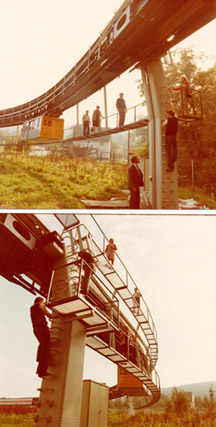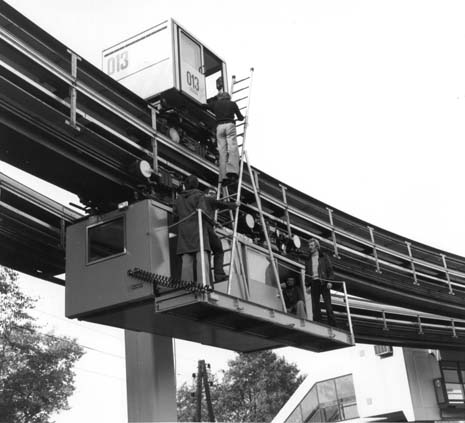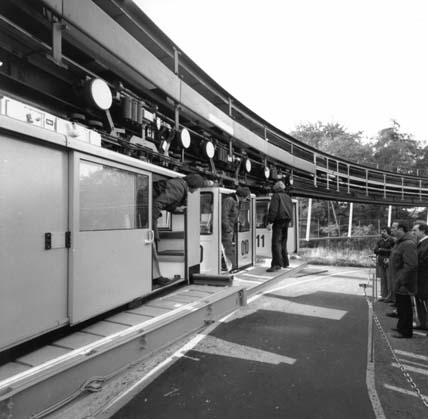Emergency Evacuation of Elevated Transit Systems
Shown below are photos of an emergency evacuation walkway demonstration for the Cabintaxi PRT system. This work was conducted at the Hagen test facility in Germany in the mid-1970s, as part of a government funding analysis of evacuation issues as they relate to small-vehicle automated transportation systems.


The German transportation safety authorities were integrated into every aspect of the Cabintaxi system development. The resultant of this was a successfully developed system in which no walkway is required. The above pictures only demonstrate the thoroughness that took place at the Hagen test facility.
Cabintaxi designers and government directed safety experts used this demonstration project to gain experience from the new system to combine with real world knowledge to more fully explore the elements of the evacuation and safety issue. The Cabintaxi system underwent extensive fire testing, reliability analysis and demonstration, and over 400,000 miles of endurance testing, in the process of satisfying all of the involved agencies - the Hamburg Hochbahn, the Technischer Überwachungsverein (TÜV), the German Railway, and the Federal Ministry of Research and Technology – that public safety would not be placed in jeopardy through the installation of this new technology. The development team, in cooperation with the safety authorities, knew early on the issues that had to be dealt with to allow the system to be implemented without walkways, and worked together uncompromisingly in achieving these goals.
With a recognition that no transit property in the world wants a situation where passengers evacuate without supervision, the final plans for the Hamburg application relied on demonstrated high system reliability and the inability of failure to introduce fire into the passenger compartment, to eliminate meaningful risks to the passengers. Should the system have encountered a rare event that caused the system to shut down, correction of the problem and restarting, was the planned action. If in the even more rare event where individuals might need to be removed from the system, the main actions would be carried out cooperatively with local trained safety authorities using surface equipment. Should a vehicle be at a location on the guideway that did not lend itself to surface access, maintenance vehicles equipped with telescoping walkways and railings (show below) were developed to access any vehicle utilizing the same or opposite level.
While the Cabintaxi system installation in Hamburg was halted, the Cabinlift system, the same core technology, was approved and installed without a walkway at it application in Ziegenhain Germany. That application is over two thousand feet in length and reaches fifty feet above the ground. It has been in daily use since 1976, and the evacuation of passengers has not been an issue.
Last modified: March 26, 2005
